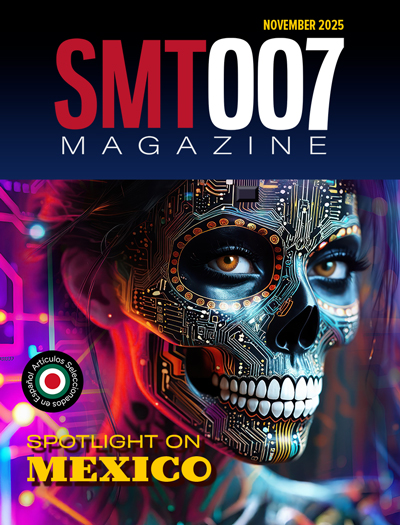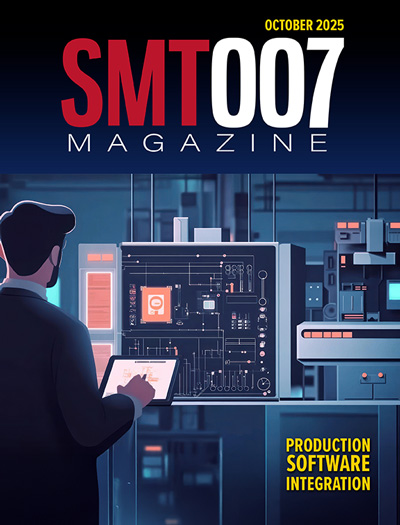-

- News
- Books
Featured Books
- smt007 Magazine
Latest Issues
Current Issue
Spotlight on Mexico
Mexico isn’t just part of the electronics manufacturing conversation—it’s leading it. From growing investments to cross-border collaborations, Mexico is fast becoming the center of electronics in North America. This issue includes bilingual content, with all feature articles available in both English and Spanish.

Production Software Integration
EMS companies need advanced software systems to thrive and compete. But these systems require significant effort to integrate and deploy. What is the reality, and how can we make it easier for everyone?

Spotlight on India
We invite you on a virtual tour of India’s thriving ecosystem, guided by the Global Electronics Association’s India office staff, who share their insights into the region’s growth and opportunities.
- Articles
Article Highlights
- Columns
- Links
- Media kit
||| MENU - smt007 Magazine
Automation and the Smart Factory: Introduction to Industry 4.0
March 20, 2019 | Happy Holden, I-Connect007Estimated reading time: 4 minutes
Editor's Note: Parts of this article include excerpts from and expansions of Automation and Advanced Procedures in PCB Fabrication.
There's a lot of talk about automation, but I find that there is very little available on automation planning. This is one of my specialties. I started by studying for an MSEE in control theory, which went well with my bachelor’s degree in chemical engineering because I specialized in process control and IC manufacturing.
Before we get started, remember that the benefits will be derived only if certain cardinal principles are observed. This article briefly outlines the background of computer-integrated manufacturing (CIM) and its evolution to Industry 4.0 and smart factories.
The characteristics of successful automation application in manufacturing depend on how well business and technical management understand and promote the strategies, tactics, and philosophies used in modern manufacturing. Successful automation implementation can be enhanced in any company, small or large, by reviewing the philosophies of CIM, automation, management roles, mechanization, SPC, TQC, Lean, MRP, and DFM.
Computer-integrated Manufacturing (CIM)
The strategies outlined here are considered CIM, but the current vocabulary now is “Industry 4.0” or “smart factories.” Products include various software, computer, networking, interface, and measurement systems. At that time, HP had been in the automation business longer than any other company. It all started with requests from the government and others for automated test and measurement systems. Because of the need to automate various measurement instruments and systems, HP created the first machine-to-machine, plug-and-play protocol called HP Interface Bus (HP-IB). This was later formalized into the IEEE-488 communication standard.
CIM architecture was defined as early as 1980 when the CASA/SME published a presentation of computer-integrated manufacturing to provide a common set of terms for its members. The ring surrounding the wheel represents various influencing factors for the development of CIM such as expertise as a human factor, productivity as an economic factor, and computer technology as a technological factor.
The wheel itself contains four functions, including engineering design, manufacturing planning, production control, and factory automation (Figure 1). If the individual functions are connected to each other and operate with a common database, an integrated system architecture is created and represented by the hub of the wheel. This development has resulted in the realization that CIM, apart from factory automation and functions, is indirectly related to the operational performance, such as design (product/process), and production planning and control.
Additionally, CIM is linked to common business administrative tasks such as manufacturing management, strategic planning, finance, marketing, and human resource management. A further innovation was the addition of information resource management and communications between the different functions. Therefore, a common database alone is insufficient for achieving integration. The all-embracing nature of the CIM wheel reflects the idea promoted by CASA/SME that CIM must be viewed as a concept embracing the company as a whole.
The Outer Ring
The common business administrative tasks related to CIM are located on the outer ring of the wheel. They primarily form the company’s connection to the outside world. Data processing applications can be found in the most diverse areas. Most software systems applied in these areas were originally self-styled developments, which are increasingly being replaced with standard commercial software packages. Currently, this software is installed primarily on mainframes. Overlaps of its functionality exist mainly with the software of the production planning and control.
The Inner Ring
Functions related to the operational performance of the company are located on the inner ring of the wheel. Data processing applications for the development and design area are CAD simulations; analysis programs, such as the finite element method (FEM); and drawing storage and management, such as group technology (GT).
The types of data found in this area are diverse, including drawings, technical specifications, and bills of materials (BOMs). Moreover, data in manufacturing companies is often disorderly. There may be several types of part numbers and BOMs, or more than one GT or CAD system, each with its own computer internal representation of geometric data. The applied software rarely runs on the same hardware, resulting in many different hardware systems.
The second group of applications on the inner ring of the wheel is attributed to process planning, production planning, and control. It comprises tasks—such as routing generation, resource planning, material requirements planning, capacity planning, order distribution, supervision—and planning of quality assurance—such as quality process and resource planning. In the United States, software in the production planning and control area mostly runs on large clients or servers, although the software itself is more frequently supplied by several software houses and not by the computer vendor.
As in the common business administrative area, the software packages, which are integrated within themselves, have a modular structure and their single components can also be bought and applied. Therefore, a company rarely purchases and installs all modules of such a package. This results in functional overlaps and data redundancy. One example of this would be material requirements, and planning and purchasing systems.
The third group on the inner ring includes the automation of manufacturing installations. Examples include robots, numerically controlled machines, flexible manufacturing systems, and computer-aided measuring and testing methods. This area is characterized by the extreme heterogeneity of the systems involved, the diversity of which being much more pronounced than in the previously mentioned groups of functions.
To read the full article, which appeared in the March 2019 issue of SMT007 Magazine, click here.
Testimonial
"We’re proud to call I-Connect007 a trusted partner. Their innovative approach and industry insight made our podcast collaboration a success by connecting us with the right audience and delivering real results."
Julia McCaffrey - NCAB GroupSuggested Items
EMS and ODM Market Size to Surpass USD 1589.62 Billion by 2033, Rising at 7.40% CAGR
11/04/2025 | Globe NewswireAccording to the SNS Insider, “The EMS and ODM market size was valued at USD 900.09 Billion in 2025E and is projected to reach USD 1,589.62 Billion by 2033, growing at a CAGR of 7.40% during 2026–2033.”
Electronics Manufacturing Powers U.S. Growth, Supporting 5.2 Million Jobs and $1.8 Trillion in Output
11/03/2025 | Global Electronics AssociationNew report from Global Electronics Association shows electronics industry contributes $853 billion to GDP and delivers average annual wages exceeding $156,000, reinforcing its role as a pillar of U.S. economic resilience.
Nolan’s Notes: Is Mexico the Pulse of Electronics in the Americas?
11/04/2025 | Nolan Johnson -- Column: Nolan's NotesLast year, I attended SMTA Guadalajara, where I saw the results of the Mexican investment in electronics manufacturing. The U.S. was still operating under the Biden administration, and while Mexican EMS companies had expanded capacity to support EV manufacturing, the demand dropped significantly. In my conversations at the show, the sentiment was one of patience. They knew the EV business would likely come back. However, they didn’t expect an overhaul of U.S. trade agreements and tariffs that would shift a more diversified portfolio in Mexico’s direction.
TTM Technologies Receives Two Awards from the Global Electronics Association at the 2025 IPC CEMAC Conference
11/03/2025 | Globe NewswireTTM Technologies, Inc. announced that two of its team members received prestigious Asia Steering Committee Outstanding Service Awards from the Global Electronics Association (formerly named IPC connecting global electronics industry) at the 2025 IPC CEMAC Electronics Manufacturing Annual Conference in Shanghai.
SMT007 Magazine November 2025: Inside Mexico’s Rise as an Electronics Manufacturing Leader
11/04/2025 | I-Connect007 Editorial TeamMexico isn’t just part of the electronics manufacturing conversation—it’s leading it. From growing investments to cross-border collaborations, Mexico is fast becoming the center of electronics in North America. In this issue, we uncover why Mexico is earning global recognition. From top-ranked manufacturing capabilities to expanding partnerships that reach far beyond the U.S.


